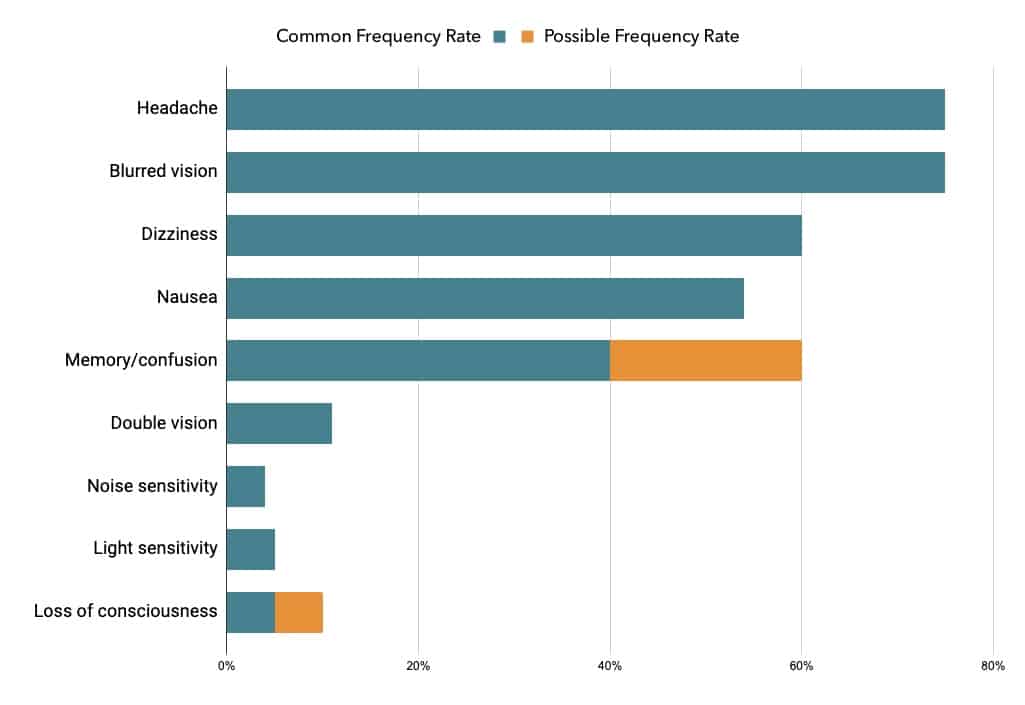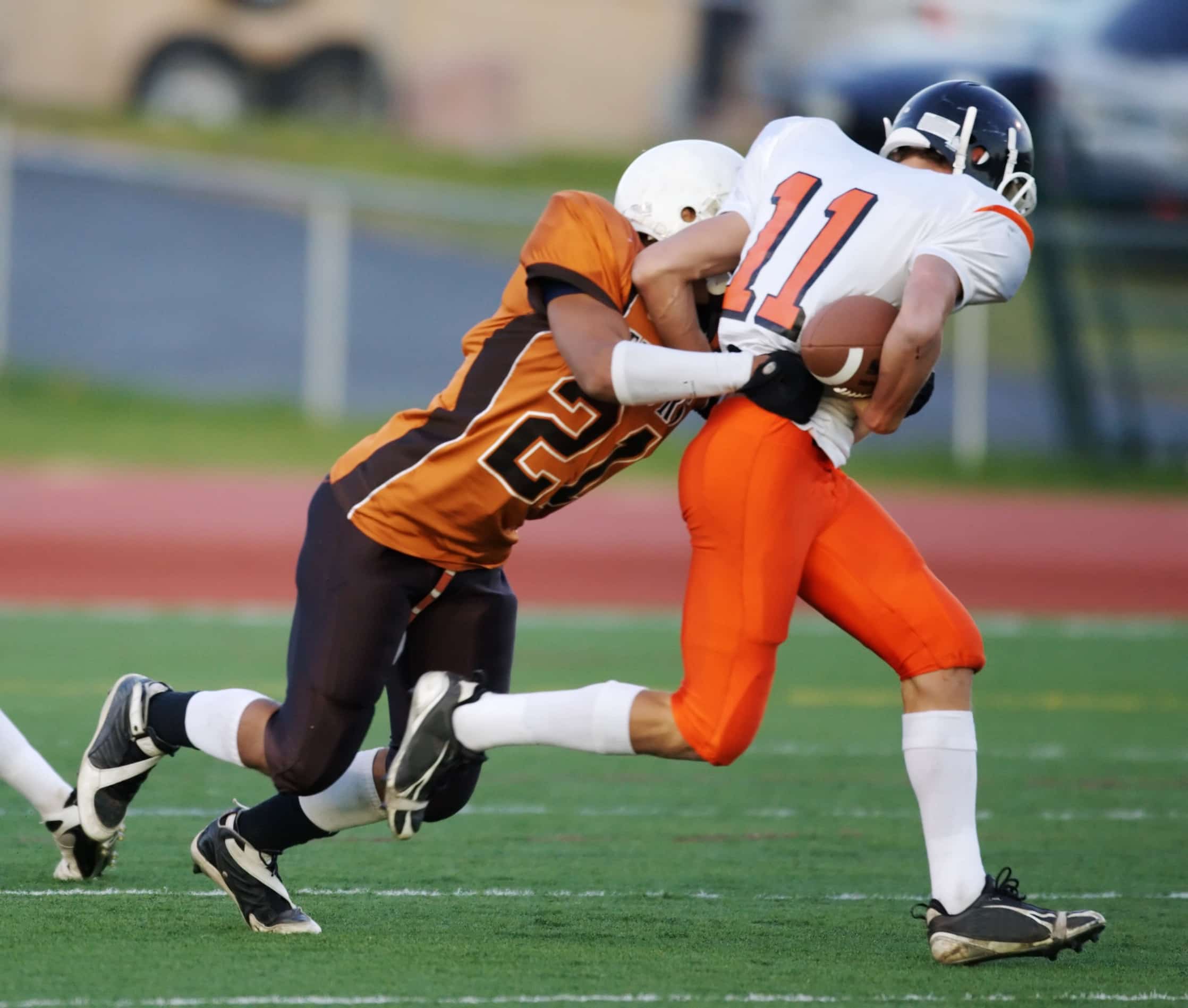
What do you know about concussions? Learn more about the symptoms, recovery, and the "Return to Play" protocol for youth sports.
A concussion is the most common type of traumatic brain injury (TBI) that can result from sudden movements of the brain inside the skull.
A direct blow, acceleration/deceleration, or a blast can cause concussions.
There are a variety of degrees of concussion types: Mild, Moderate, and Severe.
Most concussions (80-90%) resolve (meaning the symptoms improve or go away) in 2-8 weeks. If symptoms last longer, the patient will be considered to be in post-concussive syndrome at about three months after the initial incident.
Symptoms for concussions vary by individual, especially in type, intensity, and duration. Concussion symptoms may include:
An OHSU-Stanford team published an evidence-based review that found the following rates of frequency for symptoms in subjects with a concussion:

TBIs, or traumatic brain injuries, including concussions, create an imbalance in the ANS (autonomic nervous system) with many suffering from a high “sympathetic tone”—getting stuck in a fight-or-flight state. The heart rate is elevated, making the body respond poorly to increased demands; brain blood flow is not as responsive; the digestive system may shut down bringing on stomach aches, food sensitivities, and increased inflammation; anxiety levels increase; and lightheadedness may come on, especially, when doing anything more than is normal.
Concussions and whiplash go hand in hand. With every concussion, there is also a whiplash element of the initial injury. Studies demonstrate that the acceleration required for a concussion (between 70-120 G’s) is much higher than whiplash, which occurs at about 4.5 G’s. This means that anytime a concussion occurs, it’s highly likely that whiplash has also occurred. This means that there is a very high likelihood that a neck injury will be included with a concussion.
In fact, post-concussive syndrome symptoms are extremely similar to whiplash and neck pain symptoms, including: headaches, cognition difficulties, mood swings, balance issues, and more.
For concussions, chiropractors can help manage care with a treatment plan and helping work on muscles and proprioceptive neurological training, to help heal the nerves that may have been affected by the concussion. If the symptoms are not improving, or you may be helped by additional services, we’ll refer you out. We may refer you to vision specialists, neurologists or psychiatrists to help with your symptoms.
Chiropractic is also an effective treatment for neck injuries, especially in patients suffering from whiplash. It’s able to reduce inflammation to surrounding affected muscles and ligaments and it restores neck and shoulder mobility. (Quick reminder: Where there’s a concussion, there’s a neck injury.)
If you are hoping to accelerate the healing of your concussion, it starts with proper nutrition, sleep hygiene, and exercise. Additionally, try to avoid getting more concussions—the more concussions you have, the worse the symptoms may be. (Choose a sport that’s not as contact-heavy, for example.)
Avoid pro-inflammatory foods such as refined sugars, white bread, pasta, and artificial sweeteners. Instead, eat healthier options that work toward healing your body, like fruits, vegetables, fresh-caught fish (salmon, mackerel, herring) and good fats such as coconut oil, flax seed, and almonds. This can help you offset the ongoing inflammatory response and reduce your concussion symptoms. Omega-3s (in supplement or in foods like fish, vegetable oils, walnuts, brussels sprouts, spinach and broccoli) can also help provide better nutrition to help your body’s natural healing processes as well.
Getting good sleep after a concussion is harder than it sounds. In fact, it’s a Hollywood fallacy that concussions make you fall asleep quickly. More often than not, the patient will instead be very tired and unable to fall asleep. (Loss of consciousness is another thing entirely.) Maintain a good sleep pattern, and work on getting better sleep by:
Waking at the same time every day
Getting sun exposure in the morning
Avoiding caffeine and daytime naps
Exercising in the morning
Limiting screen time, especially at night
Keeping the bedroom cool
Some recent evidence suggests that exercise can help speed recovery in the early stages after a concussion, as well.
Most of all, take the time to rest after a concussion. Take a break from school and sports until you feel like you’re improving.

Concussions occur regularly in sports. Limiting a return to play is best for all involved. In the State of Oregon, the law mandates specific standards to be met before you can go back into playing the sport. The athletic director cannot sign it, but a chiropractor can. These are the steps to Return to Play:
If a child gets a concussion, they will get pulled from play, do steps 1-6 (which could take anywhere from 1 week or up to 1 month), and then the chiropractor (us) can sign off for the child to return to gameplay. At Element Chiropractic, we are trained and experienced at releasing student-athletes back to full contact play safely in accordance with the Oregon requirements.
Call Element Chiropractic so we can also help manage your symptoms and pain and help keep an eye on you.